In this article, You will read Apiculture in India – for UPSC IAS.
Apiculture in India
- Apiculture is the science and culture of honeybees and their management.
- Beekeeping is the practice of intentional maintenance of honey bee colonies, commonly in hives, by humans.
- A beekeeper may keep bees in order to collect honey and beeswax, or for the purpose of pollinating crops, or to produce bees for sale to other beekeeper. A location where bees are kept is called an apiary.
- Beekeeping (or apiculture, from Latin: apis “bee”) is the maintenance of honey bee colonies, commonly in hives, by humans.
- In India beekeeping has been mainly forest based. Several natural plant species provide nectar and pollen to honey bees.
History of Beekeeping
- Globally, there are more than 20,000 species of wild bees, many of which are solitary or which rear their young in burrows and small colonies, like mason bees.
- Commercially it is done in Himanchal Pradesh where locals collect honey on hills and in forests.
- Beekeeping, or apiculture, is concerned with the practical management of the social species of honey bees which live in large colonies of up to 100,000 individuals.
Honey Bees-different Species in India
- Five important species of honey bees are as follows-


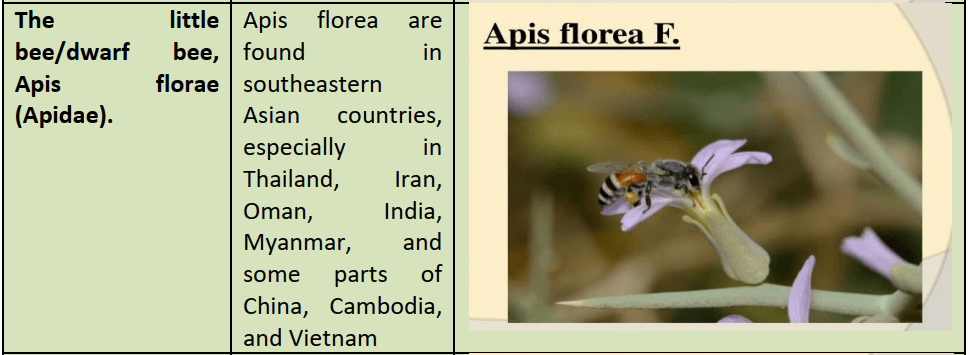


Types Of Beekeepers
- Beekeepers generally categories themselves as:
- Commercial beekeeper: Beekeeping is the primary source of income.
- Sideliner Beekeeping: Beekeeping is a secondary source of income.
- Hobbyist – Beekeeping is not a significant source of income.
Methods Of Apiculture
Commercial production of honey is done by two methods, namely indigenous method and modern method. To obtain pure and more amount of honey modern methods of apiculture are in practiced.
Indigenous method of bee keeping
- This is the primitive and unplanned method of apiculture. In this method, two types of hives are used.
- Natural fixed combs prepared by bees on the walls or the branches of trees
- Artificial or man-made movable hives. These hives are made from wooden logs or earthen pots etc.
- In the indigenous method, the bees are first killed or made to escape from the hive with the help of smoke when the bees are at rest during the night. This method has many drawbacks and it is not suitable for
- commercial large-scale production of honey. The following are the disadvantages of the indigenous method:
- The honey cannot be extracted in pure form. The extracted honey also contains the larvae, pupae, and pollen cells.
- The future yield of the honey is affected as the colony has to be destroyed to extract the honey. Moreover, it takes a lot of energy of the bees to build a new hive.
- The bees may not construct the new hive in the same place as the old one.
- The natural hives also have the danger of attack by the enemies like rats, monkeys, ants, etc. The natural hives can also be damaged by climatic factors.
- Also, scientific intervention is difficult in the indigenous method, and thus improving of the bee race is impossible.
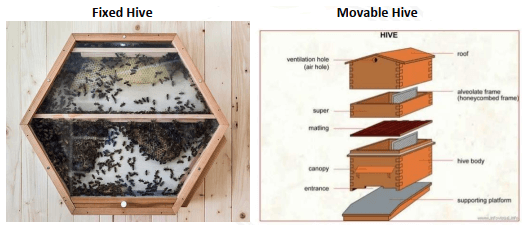
Modern Method of apiculture
- In the modern method of apiculture the honey bees are reared in movable artificial hives. This was designed and invented by Longstroth in 1951. This invention has turned apiculture into a cottage industry and has provided employment to lakhs of people.
- The methods used here are:
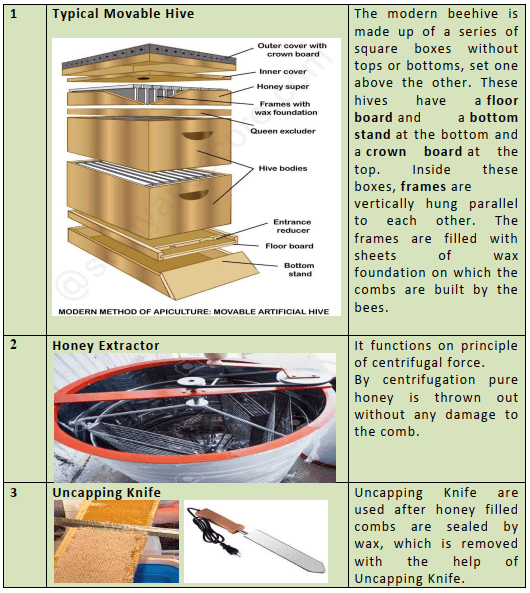
Utility of honey
- Honey is a nutritious food, rich in energy and vitamins. Our body readily absorbs sugar, minerals, vitamins, and other materials from honey. The various uses of honey are:
- It is used in the formation of candles cakes and bread.
- It is a laxative, antiseptic, and sedative and used in Ayurvedic and Unani medicinal systems. It Acts as a curative of ulcers on the tongue and alimentary canal. Typhoid germs are killed by it.
- It is used as a preservative, in the brewing industry, in poultry, and fishing industries.
- It is used to stimulate the growth of plants, the bacterial culture, in insect diet.
Production of Honey in World
- China is the largest honey producer in the world and exporting the largest amount of honey to other countries.
- After China, Turkey, USA, Iran, Russia, Ukraine, India, Mexico, Brasil, Canada, Malaysia, Germany, Bulgaria, New Zealand, Spain and Michigan are also known as the most biggest honey producer countries in the world.
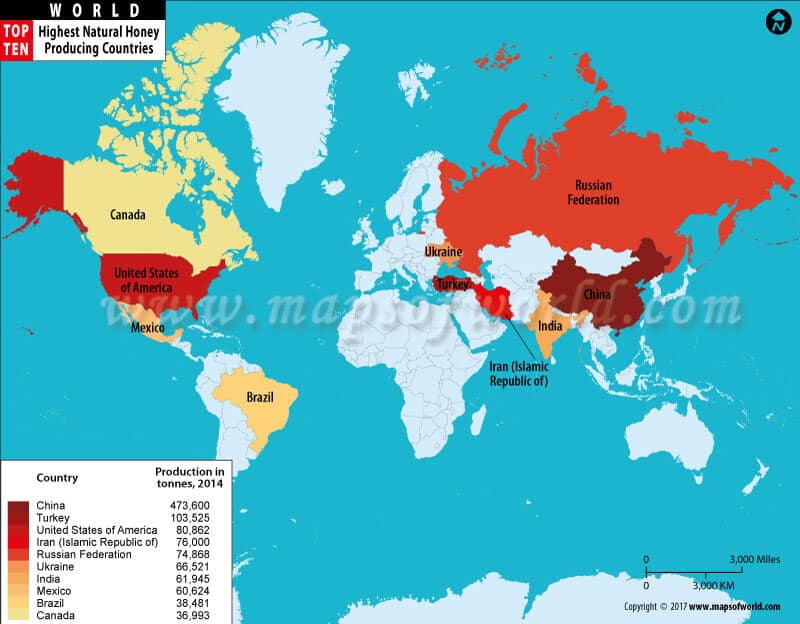
Production of Honey In India
- The establishment of the Khadi and Village Industries Commission to revitalize the traditional village industries hastened the development of beekeeping in 1980s.
- The production of honey in India increased significantly towards the late 1990s. 70% of honey production comes from informal segments. As a major exporter of honey, India falls behind China, Argentina, Germany, Hungary, Mexico, and Spain.
- West Bengal, Uttar Pradesh, Punjab, and Bihar, contribute about 61% of India’s total honey production. If you talk about the collection of revenue from the honey market as per the reports of 2018, India has generated INR 15,579 million.
- As per the latest data from the National Bee Board, under the Department of Agriculture, the country’s total honey production reported in 2017–2018 was 1.05 lakh metric tonnes (MTs), compared to the 35,000 metric tonnes in 2005-2006.
- India has exported 61,333.88 MT of Natural Honey to the world for the worth of Rs. 732.16 Crore/ 105.48 USD Millions during the year of 2018-19. U S A, United Arab Emts, Saudi Arab, Morocco, and Qatar are the Major Export Destinations (2018-19).
- India has a potential of about 200 million bee colonies as against 3.4 million bee colonies today.
- Increasing the number of bee colonies will not only increase the production of bee-related products but will boost overall agricultural and horticultural productivity.
- As per the National Bee Board and Ministry of Agriculture & Farmers’ Welfare India’s honey exports have jumped from 29.6 to 51.5 thousand tonnes between 2014-15 and 2017-18.
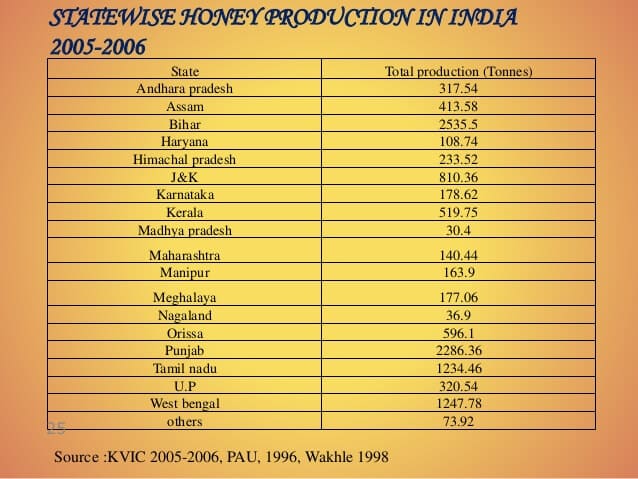
Beekeeping Development Committee
Bibek Debroy led the beekeeping development committee under the Economic Advisory Council to the Prime Minister has made recommendations to enhance the contribution of the beekeeping sector for achieving the target of doubling of farmer incomes by 2022.
The committee was set up to identify ways of advancing beekeeping in India that can help in improving:
- Agricultural productivity.
- Enhancing employment generation.
- Augmenting nutritional security.
- Sustaining biodiversity.
Key Recommendations
- Institutionalize the National Bee Board and rename it as the Honey and Pollinators Board of India under the Ministry of Agriculture and Farmers’ Welfare as it will help in advancing beekeeping through multiple mechanisms such as:
- Setting up of new integrated bee development centers and strengthening the existing ones.
- Creating a honey price stabilization fund.
- Collection of data on important aspects of apiculture.
- Simplifying procedures and specify clear standards for ease of exporting honey and other bee products.
- Beekeeping should not be restricted to honey and wax only instead marketing of bee products such as pollen, propolis, royal jelly, and bee venom can contribute to the income of Indian farmers.
- Recognize honeybees as inputs to agriculture and consider landless beekeepers as farmers.
- Training and development of beekeepers should be provided by state governments.
- National and regional infrastructure should be developed for the storage, processing, and marketing of honey and other bee products.
- Plantation of bee-friendly flora at appropriate places and engaging women self-help groups in managing such plantations.
- Recognition of apiculture as a subject for advanced research under the aegis of Indian Council for Agricultural Research.
National Bee Board (NBB)
- Small Farmers’ Agri-Business Consortium (SFAC) registered National Bee Board as a society under the societies registration Act, 1860 in 2000.
- National Bee Board (NBB)was reconstituted (with the secretary as chairman) in June 2006.
- The main objective of the National Bee Board (NBB) is the overall development of beekeeping by promoting scientific beekeeping in India to increase the productivity of crops through pollination and increase the honey production for increasing the income of the Beekeepers/ Farmers.
- Presently NBB is implementing National horticulture mission (NHM) and Horticulture Mission for North East and Himalayan State (HMNEM).
Conclusion
- Production of honey has been the major aim of the industry.
- Modern beekeeping also includes the production of beeswax, bee collected pollen, bee venom, royal jelly, propolis, as also of package bees, queen bees, and nucleus colonies,
- About 10,000 tons of forest honey is produced in India annually.

Is there any govt subsidies in beekeeping
We need more training and honey flow give to increase honey production